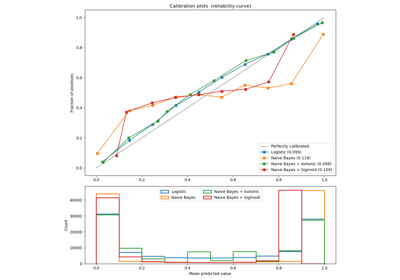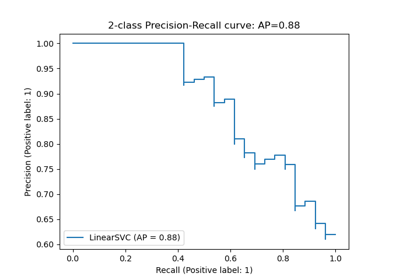sklearn.metrics.f1_score¶
-
sklearn.metrics.f1_score(y_true, y_pred, *, labels=None, pos_label=1, average='binary', sample_weight=None, zero_division='warn')[source]¶ Compute the F1 score, also known as balanced F-score or F-measure.
The F1 score can be interpreted as a weighted average of the precision and recall, where an F1 score reaches its best value at 1 and worst score at 0. The relative contribution of precision and recall to the F1 score are equal. The formula for the F1 score is:
F1 = 2 * (precision * recall) / (precision + recall)
In the multi-class and multi-label case, this is the average of the F1 score of each class with weighting depending on the
averageparameter.Read more in the User Guide.
- Parameters
- y_true1d array-like, or label indicator array / sparse matrix
Ground truth (correct) target values.
- y_pred1d array-like, or label indicator array / sparse matrix
Estimated targets as returned by a classifier.
- labelsarray-like, default=None
The set of labels to include when
average != 'binary', and their order ifaverage is None. Labels present in the data can be excluded, for example to calculate a multiclass average ignoring a majority negative class, while labels not present in the data will result in 0 components in a macro average. For multilabel targets, labels are column indices. By default, all labels iny_trueandy_predare used in sorted order.Changed in version 0.17: Parameter
labelsimproved for multiclass problem.- pos_labelstr or int, default=1
The class to report if
average='binary'and the data is binary. If the data are multiclass or multilabel, this will be ignored; settinglabels=[pos_label]andaverage != 'binary'will report scores for that label only.- average{‘micro’, ‘macro’, ‘samples’,’weighted’, ‘binary’} or None, default=’binary’
This parameter is required for multiclass/multilabel targets. If
None, the scores for each class are returned. Otherwise, this determines the type of averaging performed on the data:'binary':Only report results for the class specified by
pos_label. This is applicable only if targets (y_{true,pred}) are binary.'micro':Calculate metrics globally by counting the total true positives, false negatives and false positives.
'macro':Calculate metrics for each label, and find their unweighted mean. This does not take label imbalance into account.
'weighted':Calculate metrics for each label, and find their average weighted by support (the number of true instances for each label). This alters ‘macro’ to account for label imbalance; it can result in an F-score that is not between precision and recall.
'samples':Calculate metrics for each instance, and find their average (only meaningful for multilabel classification where this differs from
accuracy_score).
- sample_weightarray-like of shape (n_samples,), default=None
Sample weights.
- zero_division“warn”, 0 or 1, default=”warn”
Sets the value to return when there is a zero division, i.e. when all predictions and labels are negative. If set to “warn”, this acts as 0, but warnings are also raised.
- Returns
- f1_scorefloat or array of float, shape = [n_unique_labels]
F1 score of the positive class in binary classification or weighted average of the F1 scores of each class for the multiclass task.
Notes
When
true positive + false positive == 0, precision is undefined. Whentrue positive + false negative == 0, recall is undefined. In such cases, by default the metric will be set to 0, as will f-score, andUndefinedMetricWarningwill be raised. This behavior can be modified withzero_division.References
Examples
>>> from sklearn.metrics import f1_score >>> y_true = [0, 1, 2, 0, 1, 2] >>> y_pred = [0, 2, 1, 0, 0, 1] >>> f1_score(y_true, y_pred, average='macro') 0.26... >>> f1_score(y_true, y_pred, average='micro') 0.33... >>> f1_score(y_true, y_pred, average='weighted') 0.26... >>> f1_score(y_true, y_pred, average=None) array([0.8, 0. , 0. ]) >>> y_true = [0, 0, 0, 0, 0, 0] >>> y_pred = [0, 0, 0, 0, 0, 0] >>> f1_score(y_true, y_pred, zero_division=1) 1.0...



